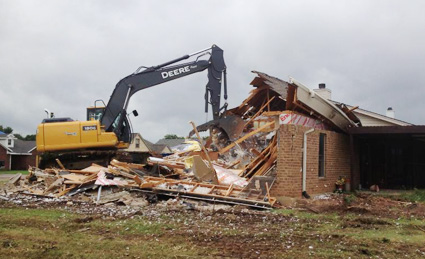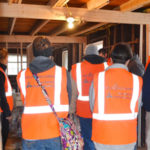It’s much quieter these days in West, the Central Texas town partially flattened by a deadly fertilizer plant explosion in April 2013.
Gone are the convoys of semis and church trailers hauling debris and construction supplies, lawn equipment and food. Missing are the masses of teen, middle-aged and senior citizen volunteers, decked in fluorescent T-shirts, wielding shovels, wheelbarrows and coolers filled with ice water.
 John CrowderAnd local residents—not visitors from Oklahoma, Arkansas and other parts of Texas and the nation—do most of the residential mowing and weed cutting nowadays.
John CrowderAnd local residents—not visitors from Oklahoma, Arkansas and other parts of Texas and the nation—do most of the residential mowing and weed cutting nowadays.
One more sign indicates West is moving on from the blast that killed 15 and injured 226. John and Lisa Crowder are set to move into a newly constructed home.
“Yesterday, the developer showed me the certificate of occupancy and that it’s OK for me to move home,” John Crowder, the pastor at First Baptist Church of West, said Oct. 8. “That was a very moving time.”
While the Crowders aren’t unique among West residents for feeling emotional about moving back into permanent homes, the family is among the last in town to do so. Of about 120 houses destroyed, only 10 or fewer remain either to be built, finished or moved into, Crowder estimated.
That’s because Crowder, 50, has spent the better part of the last 17 months consumed with leading local efforts to help others rebuild their lives and homes, said Marla Bearden, specialist with Texas Baptists’ Disaster Recovery program.
Crowder served on the board of the long-term recovery effort, worked with other religious leaders in town to coordinate financial aid and opened his church to volunteers and volunteer coordinators for numerous recovery projects in the city, said Bearden, who helped coordinate the “Loving West” recovery effort that drew nearly 800 volunteers to West for a week in June 2013.
 The Crowder home being demolished in May, 2013. (Facebook photo)The massive effort involved local, state and federal agencies. It also was volunteer-intensive, Bearden said, because extensive media coverage created great interest in the response and recovery of West.
The Crowder home being demolished in May, 2013. (Facebook photo)The massive effort involved local, state and federal agencies. It also was volunteer-intensive, Bearden said, because extensive media coverage created great interest in the response and recovery of West.
Of the 2,500 volunteers who moved through West from Texas Baptists’ efforts alone, Crowder likely dealt with most of them directly or indirectly.
“John was right there working with the community and with those (long-term recovery) case managers,” Bearden said. “He really put himself and his family last, and members of the community first.”
All the while, the Crowders lived a nomadic existence, staying in borrowed spaces while the rest of the town rebuilt.
Their original house on Northridge Circle was located about a quarter-mile from the West Fertilizer Co. plant. The ammonium nitrate explosion created immense structural damage to the Crowder home and across the entire neighborhood.
“The rafters were poking through the roof, and most of the ceilings had come down,” Crowder said. “In the bedrooms that faced the plant, there were shards of glass imbedded in the wall on the far wall from the windows. So, we were blessed that we were not home.”
Authorities cordoned off the house, which eventually had to be demolished, and the entire neighborhood.
Next, the Crowders lived in a series of temporary dwellings.
“We moved four times in six weeks,” he said.
The night of the explosion, they stayed in the home of a First Baptist deacon and remained there about a week.
 What was left of the Crowder home in West, Texas, after its demolition in 2013.From there, they moved into the home of a church member on an extended vacation. That was followed by a brief hotel stay.
What was left of the Crowder home in West, Texas, after its demolition in 2013.From there, they moved into the home of a church member on an extended vacation. That was followed by a brief hotel stay.
Finally, the deacons purchased a doublewide trailer, where the family has lived ever since.
“I didn’t know they made mobile homes that nice. We were overwhelmed,” he said.
But Crowder quickly found the rest of his life overwhelming, too.
Within hours of the tragedy, First Baptist began getting inquiries both from those who wanted to help and those who needed it.
Pretty soon, Crowder found it was all he could do to keep up with that unfolding process and meet his obligations as the pastor of a church.
“In disaster recovery, you pretty much throw out your job description,” he said.
“For me, everything changed except I still preached Sunday mornings—which in itself is a challenge when you are going through personal trauma and the community is suffering,” he acknowledged.
He served in one job that had been relatively low-stress before the explosion—treasurer for the local ministerial alliance. After April 2013, its voucher system came into great demand—and operated through the treasurer.
First Baptist was even busier. The congregation quickly became the de facto headquarters of agencies like Texas Baptist Men, the Baptist General Convention of Texas and others.
 First Baptist Church became the hub for the recovery effort in West.First Baptist also began coordinating free demolitions, facilitating 60 altogether and saving families between $12,000 and $24,000.
First Baptist Church became the hub for the recovery effort in West.First Baptist also began coordinating free demolitions, facilitating 60 altogether and saving families between $12,000 and $24,000.
Meanwhile, individuals arrived for the vouchers and sometimes showed up individually to volunteer. The Long Term Recovery Center eventually took over most of those services, but for many months, First Baptist was a place on the move.
“We nicknamed it ‘Grand Central Baptist,’” Crowder said. “It became the hub of activity for the recovery effort there for a while.”
West still is in recovery mode, Crowder said, but now is mostly on its own, and that’s just the way residents want it.
“It has stopped being the primary point of conversation,” he said of the blast. “But that is by choice. People are so emotionally exhausted, they don’t want to talk about it anymore.”
The visible volunteer support in West is much less than it was. Residents are not resentful of that, because they understand there are others in need, he said.
But a strong need for financial and prayer support in West remains, he added.
Crowder acknowledged his family still needs to recover, too, and their new house will help with that.
The new home was built on the same lot and using the same floor plan, the same brick, the same colored shingles, “so we feel like we are coming home.”
Like in most every other part of West, the Crowder family is on the verge of returning to life as it was before April 17, 2013.
“It’s almost like the end of my personal recovery,” Crowder said of moving into the home.
“The night it happened, we could not come home, and we have not been home yet. So going home—that means something.”















We seek to connect God’s story and God’s people around the world. To learn more about God’s story, click here.
Send comments and feedback to Eric Black, our editor. For comments to be published, please specify “letter to the editor.” Maximum length for publication is 300 words.